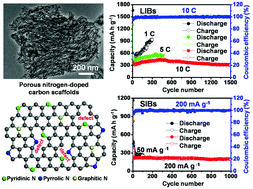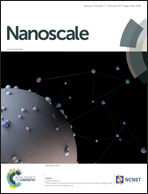Bottom-up synthesis of nitrogen-doped porous carbon scaffolds for lithium and sodium storage†
Abstract
Here we report an effective bottom-up solution-phase process for the preparation of nitrogen-doped porous carbon scaffolds (NPCSs), which can be employed as high-performance anode materials for both lithium-ion batteries (LIBs) and sodium-ion batteries (SIBs). The as-obtained NPCSs show favorable features for electrochemical energy storage such as high specific surface area, appropriate pore size distribution (3.9 nm in average), large pore volume (1.36 cm3 g−1), nanosheet-like morphology, a certain degree of graphitization, enlarged interlayer distance (0.38 nm), high content of nitrogen (∼5.6 at%) and abundant electrochemically-active sites. Such a unique architecture provides efficient Li+/Na+ reservoirs, and also possesses smooth electron transport pathways and electrolyte access. For LIBs, the anodes based on NPCSs deliver a high reversible capacity of 1275 mA h g−1 after 250 cycles at 0.5 C (1 C = 372 mA g−1), and outstanding cycling stabilities with a capacity of 518 mA h g−1 after 500 cycles at 5 C and 310 mA h g−1 after 1500 cycles even at 10 C. For SIBs, the anodes based on NPCSs display a reversible capacity of 257 mA h g−1 at 50 mA g−1, and superior long-term cycling performance with a capacity of 191 mA h g−1 after 1000 cycles at 200 mA g−1.



 Please wait while we load your content...
Please wait while we load your content...